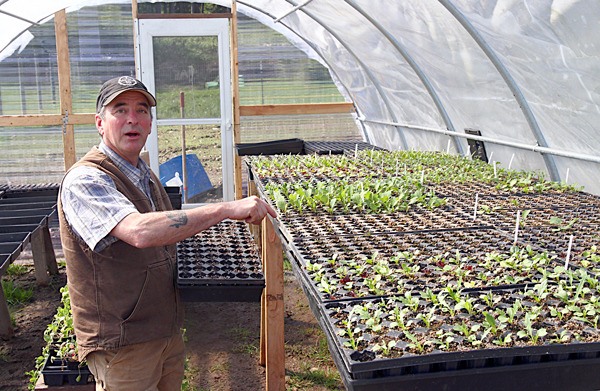Few restaurants have a dedicated farm providing their own exclusive beef, vegetables and eggs. But Seattle’s Bateau and several other Seattle eateries under the same ownership are the exclusive consumers of those commodities from La Ferme des Anes (The Donkey Farm), a bucolic Freeland farm with views of the Cascades.
Despite its name, La Ferme has no donkeys yet, though those animals are a favorite of Renee Erickson, the Bateau chef who owns the restaurant along with business partners Chad Dale and Jeremy Price, together operating as Sea Creatures LLC.
Sea Creatures also owns General Porpoise, The Walrus and the Carpenter, and The Whale Wins, all of which serve some of the food grown at La Ferme.
What it lacks in donkeys, La Ferme makes up for in other species. It has 42 cattle representing three French breeds, nine sheep and 200 chickens of four breeds — plus a border collie named Sally to wrangle the animals and a Jack Russell terrier named Pixie to kill rats.
It also has a greenhouse for vegetable starts and a half-acre of garden space — set to expand to two acres this season — growing agretti (a vogue, exotic Italian vegetable), collards, Flageolet beans, garlic, lettuce, peppers, shell beans, French string beans and tomatoes, among many other things.
All this on 45 leased acres that were fallow and empty just a year ago.
“There is a lot going on here,” said Paul Houser, who manages the farm with the help of one part-time hand. “I don’t get a lot of vacation.”
The vegetables are apportioned among all the Sea Creatures restaurants. All the eggs go to General Porpoise, a high-end donut shop. The beef goes exclusively to Bateau, which serves up an entire animal every two weeks. For now, none of the restaurants are serving mutton, though it may be offered as a special this spring and will be a menu item in the future, said Price.
Vegetable starts are constantly being planted and then, when they’re two weeks old, they’re transplanted into the garden. “We always want to have fresh product, and we want to be able to grow through November,” Houser said.
How many vegetables does the farm produce in a season?
“I really can’t say,” Houser said. “Pounds and pounds of them.”

La Ferme’s sheep are of the Katahdin breed. They grow hair rather than wool, giving them less of a “muttony” flavor, he said. They’re typically slaughtered at 18-24 months, but none are even one year old yet.
La Ferme’s chickens are one of four breeds: Araucana, Cuckoo Maran, Rhode Island Red or Welsummer. They are free range in the real sense: they can choose to strut inside their cavernous 1930s-era barn or outside in a fenced, grassy area. The Araucanas lay eggs in lovely, subtle shades of green and blue. Together, they lay about 60 eggs a day, though within two months the farm will be producing as many as 120 eggs a day, Houser said. The eggs are trucked over to Seattle every 10 days.
The cattle are also special. All are purebred stock of either the Charolais, Limousin or Maine-Anjou breed. “They are the highest-quality genetics you can get on the planet,” Houser said.
Why three different breeds? “We’re trying to see which calves will grow faster,” Houser said. “We’re looking for the top breed.”
Though considered exotic breeds in the United States, the cows don’t need any special care, Houser said. “They breed easy, they birth easy and they’re hardy,” he said.
The cattle eat grass or alfalfa hay exclusively, never grain. “Cattle aren’t meant to eat grain, and when they do, the grain gets rancid and they get sick, so you need to pump them full of antibiotics,” Houser said.
Do the exotic breeds taste better than, say, familiar breeds like Angus? Price thinks so.
“I agree feed makes a big difference, but given two different breeds with the same diet, they will taste different,” he said. Providence Cicero, the Seattle Times’ restaurant critic, went further, recently giving Bateau the only perfect (four stars) rating she has ever bestowed.
Eight of the farm’s cows — four months’ worth of meat, at the current consumption rate — are now the ideal age for slaughter: 24 months. Two will be trucked later this month to Burk Ridge Farms, in Custer, to be slaughtered and then transported down to Bateau as four beef halves. There they will hang in a cooled dry-aging room, displayed to diners through a huge picture window until they are butchered on site and served.
Each animal is worth as much as $18,000, figuring their gross value in cuts of meat sold in the restaurant, Houser said.
Eventually, though possibly as long as 10 years from now, Sea Creatures intends for the farm to be self-sustaining economically, Price said.
“It’s not a vanity project or a lark. It needs to stand on its own.”


